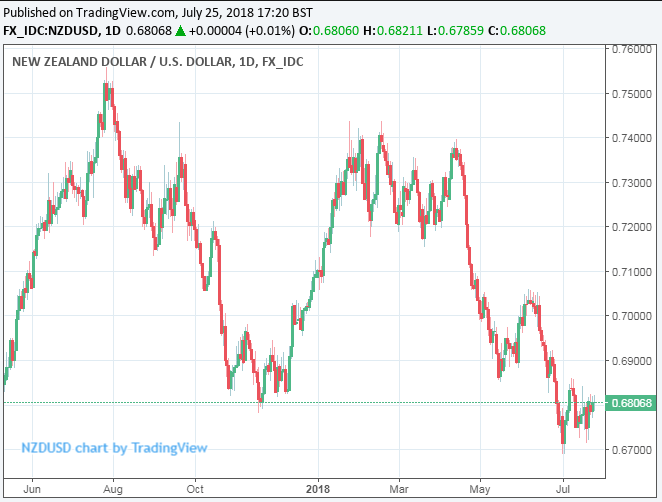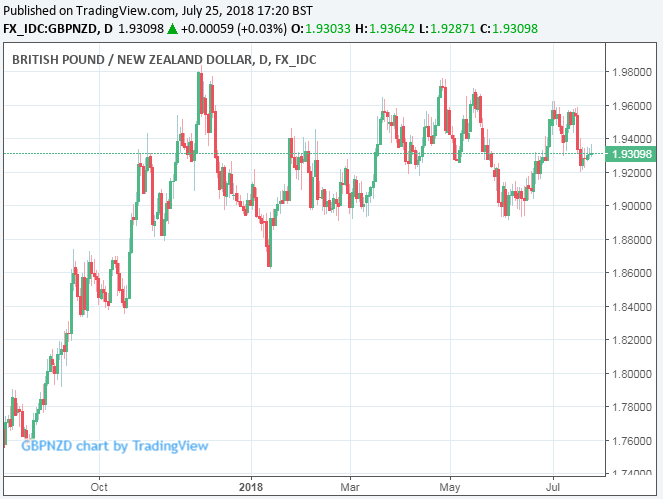New Zealand Dollar: "Stay Short Antipodeans" say J.P. Morgan as Others Call Time on Rout
- Written by: James Skinner
-
-NZD rises but J.P Morgan say "stay short" as losses will resume.
-Trade war threat and dire interest rate outlook to drive losses.
-But CIBC Capital Markets say worst is over, forecast NZD higher.

© Naru Edom, Adobe Stock
The New Zealand Dollar rose against many of its rivals Wednesday but observers should expect fresh losses over coming months, according to analysts at J.P. Morgan, who say the Kiwi interest rate outlook and a growing "trade war" threat will soon clobber the currency once more.
Wednesday's price action comes as the New Zealand Dollar continues to enjoy a tailwind of support after second-quarter inflation numbers, released on Tuesday, suggested Kiwi consumer price pressures may now be beginning to build.
This is important for the currency because it gives hope to markets that the Reserve Bank of New Zealand may be able to raise its interest rate sooner than previously thought. However, the J.P. Morgan team are suggesting such hopes may be foolhardy and forecast continued pressure on the currency during the months ahead.
"The short Antipodean view represents our structural bearish view on both currencies on the expectation that unlike a lot of G10 central banks, the RBA and RBNZ will remain on hold and these currencies would be the most vulnerable in G10 given recent escalation in trade conflict," says Meera Chandan, an FX strategist at J.P. Morgan. "Previous estimates had printed around 1.5% for a while, but this was retroactively revised up to 1.6% for 1Q and 2Q was released at 1.7%oya."
The Reserve Bank of New Zealand has held its interest rate at a record low of 1.75% ever since the end of 2016, citing below-target inflation, weak wage growth and a challenging outlook for the economy. Kiwi inflation has been below the midpoint of the 1% to 3% target ever since 2012.
RBNZ Governor Orr warned in May that interest rates will remain at current levels for "a considerable period of time," given the weakness of inflation and risks to the economy. This dealt a blow to the New Zealand Dollar, which is being increasingly undermined by interest rates that are no longer superior to those elsewhere in the world.
"Our Antipodean strategists continue to maintain their bearish stance. The increase in the RBNZ measure of inflation was modest and shouldn’t warrant substantial changes from the central bank in the context of softer growth," Chandan writes, in a recent briefing to clients. "Stay short Antipodeans through EUR/NZD and AUD/JPY Y (put vs call spread). Stay short NZD/USD put."

Above: NZD/USD rate shown at daily intervals.
The NZD/USD rate was quoted 0.07% higher at 0.6805 Wednesday but is down 3.8% this year while the Pound-to-Kiwi rate was 0.09% lower at 1.9318 but is up 1.79% for 2018.
Both performances represent heavy losses for the Kiwi Dollar, particularly after taking into account that it was up by a similar measure against the greenback and Sterling until around the end of the first-quarter.

Above: Pound-to-New-Zealand-Dollar rate shown at daily intervals.
Pricing in interest rate derivatives markets, which enable investors to protect themselves against changes in interest rates while providing insight into monetary policy, implies a cash rate below the current 1.75% in each month until June 2019, suggesting markets view an interest rate cut as more likely than an interest rate rise in the near future.
"Although the latest RBNZ communication left open the possibility of the next move being up or down, we still expect the next move to be a hike. That notion is supported by the recent acceleration in core prices in Q2 2018 and healthy labour market fundamentals that will continue to support consumption," says Avery Shenfeld, chief economist at CIBC Capital Markets. "But we don’t expect the RBNZ to pull the trigger before Q2 2019 as spare capacity is absorbed over time."
With a moribund inflation outlook aside part of what may have driven the Kiwi to the lows seen this year is its status as a commodity currency and its sensitivity to changes in sentiment toward the global economy. After all, President Donald Trump's "trade war" has led investors to fear for economic growth and financial market performance the world over this year.
"If the EU is prepared to open the door to tariff-free access for US vehicles as it has done for Japan, we could see the first step towards a negotiated solution to the global trade war. It might take longer to resolve the sticking points with China and the two NAFTA partners, but by 2019, an easing trade war will help bring the US$ back to earth," Shenfeld writes, in CIBC's monthly FX outlook.
President Donald Trump and the US are engaged in a tit-for-tat tariff fight with China, which is New Zealand's largest export market, and the European Union over allegations of unfair trade practices. Fears are that a tariff fight between the world's largest economies will quickly descend into an all out "trade war" and that this will dent economic growth in all countries it touches. But Shenfeld and the CIBC team are banking on an easing of tensions over coming months.
"Look for NZDUSD to gradually head higher, reaching 0.70 by the end of the year. Strength in H2 2019 should be limited by a slowing in global growth, however, and we’ve pared our appreciation target for the end of 2019 to 0.75 as a result," Shenfeld concludes.
Shenfeld and the CIBC team forecast the Pound-to-Kiwi rate will fall to 1.90 before year-end but that it will then rise again, to 1.96, before the end of 2019.
Advertisement
Get up to 5% more foreign exchange by using a specialist provider to get closer to the real market rate and avoid the gaping spreads charged by your bank when providing currency. Learn more here




